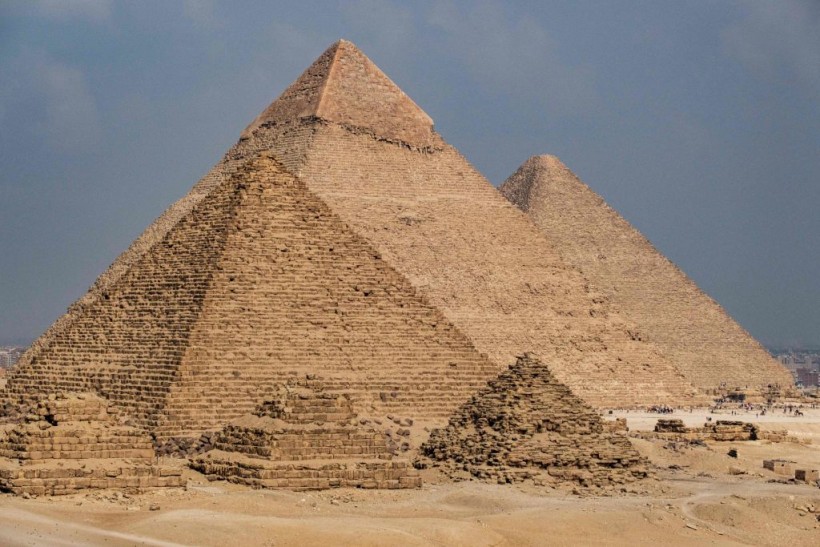The ancient Egyptian pyramids that sprang from the Giza dunes thousands of years ago are a testimony to human creativity and engineering. These massive pyramids were built to identify the tombs of ancient pharaohs.
However, the pyramids have evolved throughout the millennia, owing mostly to construction workers' repurposing of in-demand materials and theft. So, how did the pyramids appear when they were built?

(L to R) The Pyramid of Menkaure (Menkheres), the Pyramid of Khafre (Chephren), and the Great Pyramid of Khufu (Cheops) are illuminated at different levels by passing clouds at the Giza pyramids necropolis on the outskirts of the twin-city of Egypt's capital Cairo on November 4, 2022.
Original Look of Ancient Egyptian Pyramids
The ancient Egyptian pyramids, both at Giza and elsewhere, did not look as sandy brown as they do now. Rather, they were covered in a layer of glossy sedimentary rock.
Assistant Professor Mohamed Megahed from Charles University in Prague's Czech Institute of Egyptology told Live Science that all Egyptian pyramids were once encased with fine, white limestone. The casing would have provided the pyramids with a smooth, polished covering that shone under the Sun.
What did the ancient Egyptian pyramids look like when they were built? https://t.co/ENuUQwfYCL
— Live Science (@LiveScience) February 5, 2023
As per the National Museums Scotland, builders used about 6.1 million tons (5.5 metric tons) of limestone during the construction of the Great Pyramid of Giza based on one of the original limestone blocks.
The Great Pyramid is also known as Khufu's Pyramid after the pharaoh Khufu who commissioned the structure. It is the largest and oldest pyramid in Giza, although succeeding rulers of Egypt had its casing stone repurposed for other building work.
The Pyramid of Khafre, named for the pharaoh Khafre, has casing stones left around its apex that create the idea that a second peak is jammed on top of the first. Egyptologist Miroslav Verner's book "The Pyramids: The Archaeology and History of Egypt's Iconic Monuments," said that this pyramid had red granite casing around its lower floors in ancient Egypt.
More so, the third smallest major Egyptian pyramid in Giza called the Pyramid of Menkaure was said to have a red stone casing around its lower levels as well. Megahed noted that the tops of the pyramids originally hosted capstones called pyramidions, which were covered in electrum or a mixture of gold and silver that would have looked like pointy jewels of the tips of the pyramids.
READ ALSO: Egyptian Pyramids Mystery Unveiled: What's Inside? How Rich Were the Ancient Tombs of Pharaohs?
What Could Have Caused the Disintegration of the Egyptian Pyramids' Casing?
Egyptologist Mark Lehner said in a PBS/NOVA Q&A thread that the casing stones began to be peeled during Tutankhamun's reign (approximately 1336 B.C. to 1327 B.C.) and continued until the 12th Century A.D.
He said that the topmost section of the Great Pyramid was destroyed because the pyramid's outer casing was stripped of stone and used in other constructions throughout time. The stepped core stone, which is a rougher limestone than that utilized for the outer casing, is what is seen today in the pyramids.
According to BBC News, an earthquake in 1303 A.D. would have also dislodged some of the stones. The Giza pyramids still have portions of their original limestone casing. However, it seems significantly worn compared to ancient times.
RELATED ARTICLE: Egyptians' Secret to Building Pyramids With Perfect Alignment Without Advanced Tools Could Be This, Archaeologist Suggests
Check out more news and information on Archaeology in Science Times.


![Earth's Quasi-Moon Kamo‘oalewa Could Originate From Lunar Surface Not Asteroid Belt [Study]](https://1721181113.rsc.cdn77.org/data/thumbs/full/53275/89/56/50/40/earths-quasi-moon-kamo-oalewa-could-originate-from-lunar-surface-not-asteroid-belt-study.png)











